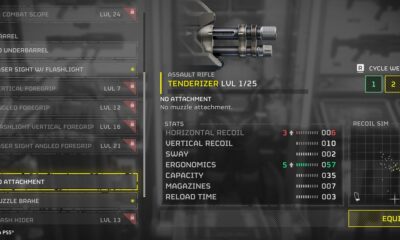Gaming
Sin & Punishment: Successor of the Earth Review

The year is 2000, a time when dial-up modems whined like banshees and your only online friends were the ones you found lurking in the shadows of IRC chatrooms. From the depths of Tokyo, a mysterious N64 game called Sin & Punishment erupts onto the scene, a lurid rail-shooter that takes cues from Neon Genesis Evangelion.
Star Fox 64 was already a bonafide hit when it came to addictive and explosive rail-shooter action. Surely Sin & Punishment: Successor of the Earth would also be a smashing success too, right? It stayed locked in Japan for seven goddamn years. It wasn’t until the Wii’s Virtual Console that the rest of the world got a taste of Treasure’s first 3D action game.
Sin & Punishment was very unique for its day. It was one of the rare N64 games to feature full English voice acting despite being a Japanese exclusive, had a dark and bloody story, and had an unusually long development time. All that blood, sweat, and tears paid off because what we got turned out to be the best action game on N64. How does it hold up decades later? Find out in this Sin & Punishment: Successor of the Earth review!
Sin & Punishment: Successor of the Earth
Developer: Treasure Co. Ltd., Nintendo R&D1
Publisher: Nintendo
Platforms: Nintendo 64 (reviewed), iQue Player, Wii Virtual Console, Wii U Virtual Console, Nintendo Switch Online +
Release Date: November 21, 2000 / October 1, 2007
Players: 1-2
Price: Only available to Nintendo Switch Online + members

It’s 2007, the future, and the world’s food supply is dwindling. Thankfully modern superscience has discovered how to synthesize genetically engineered organisms known as “Ruffians”, to become humanity’s new food supply. Think of a Ruffian as a McNugget, but edible and healthier. The only problem with Ruffian foodstuff is that, unlike McNuggets, they were unstable and mutated into ravenous monsters.
It does not take long for this finger-licking food to become finger-ripping food. To combat this delicious menace, a Multi-National Defense organization known as “Peacekeepers”, heard the beasts north of Japan. Soon enough these militant thugs started oppressing the locals with full-auto fire, which led to a revolt against the globalist fascists.
The rebellion is led by Aichi, a mysterious young female with powers. In the rebels’ ranks are Saki, an anime adonis who grunts like a man, and Airan, his devoted tomboy girlfriend. The problem that Saki and Airan face is that Aichi may not be entirely on the level with our heroes and she is grooming them to become walking weapons of mass destruction to battle a future alien threat in the sequel.

In addition to the rebellion against the Peacekeepers and the desperate struggle against the Ruffian menace, Saki and Airan must confront Aichi and her disciples. The story’s pace is relentless, leaving no room for hesitation, and the stakes escalate with each pulse-pounding scene. It’s a McRib armageddon and at the center of it all is a sacred union between a man and woman who’s child will save the future.
Players will alternate control over Saki and Airan between levels. Both of them play the same, but Saki has a Ruffian streak within. He’s got a simmering secret that threatens to boil over and turn him into one of the chomping monstrosities he’s supposed to be fighting.
Drawing inspiration from the post-apocalyptic anxieties of Japanese media after World War II, Sin & Punishment: Successor of the Earth plunges players into a nightmarish cityscape crumbling under siege. Towering skyscrapers ablaze, their steel skeletons clawing at a bruised sky choked with smoke and debris, rendered in a blurry haze of the best that the N64 can muster.
Surreal kaiju battles erupt amidst the chaos, evoking the bombastic spectacle of a Gainax anime. Colossal, otherworldly monstrosities clash amidst the concrete canyons, their grotesque forms silhouetted against the apocalyptic inferno. Blood devours the shattered remnants of skyscrapers, cascading down glass and steel, staining the concrete with a morbid beauty that both repels and mesmerizes.
Sin & Punishment: Successor of the Earth makes a powerful impression with its visuals for an N64 game from 2000. Character designs are very stylized and exaggerated to make up for the lack of nuance of early 3D. The effect is expressive body language and “cool” anime posing that reads easily amid the chaotic frantic shootouts.

By the time Treasure made Sin & Punishment, they had already made many incredible platformers and shootem-ups. After Mischief Makers, the boys at Treasure knew their next game would need to be more ambitious and they reexamined the N64 controller to fully realize its full potential.
Most N64 games relied on the “right-handed” grip of the controller, where players wield the middle and right prongs. Sin & Punishment supports several configurations, but the one that Treasure’s devs intended players to use is the “left-handed” grip. This is where players hold the left grip with their left hand and hold the middle analog stick prong with their right hand.
At the time, this method was considered very unconventional and even “uncomfortable”, yet it is surprisingly very close to the standardized “twin-stick” layout that most modern games rely on today. The D-pad moves Saki/Airan left and right and the control stick moves/aims the reticule. It feels very natural and makes Sin & Punishment feel very modern.

The left shoulder button is for jumping/double-jumping and dashing is done by double-tapping the left or right directions on the D-pad, with the Z-button for firing/slashing. If enemies or projectiles get too close, the heroes can give them a powerful whack or three-hit combo with their swords.
Controls feel fluent and responsive and aiming can be toggled to a lower damaging auto aim so players can choose to focus on evading if the action gets too spicy… which it will. For most of the game, Saki and Airan automatically dash through a fixed path.
The protagonists must dodge rocket barrages and counter Peacekeepers while blasting the shit out of anything and everything. The level of detail is breathtaking, allowing players to strategically blast apart enemy platforms or the ships they arrived on.

Sin & Punishment‘s boss battles shine when Treasure unleashes their masterful blend of genre-bending perspectives and innovative boss mechanics. These encounters transcend the typical shoot ’em-up and rail-shooter formula with dynamic perspective shifts and unique combat challenges.
Suddenly, the action might zoom out, mimicking a classic 2D side-scroller, forcing players to adopt a new strategic approach. Other times the POV shifts the player to the bottom of the screen to make space for a massive boss at the top of the screen, homaging traditional overhead scrolling shooters.
Treasure’s imaginative panache elevates Sin & Punishment‘s boss battles, proving how simple shoot ’em-up gameplay can be transformed into exhilarating and striking battles. The challenge level is fairly high on normal mode and the first time playing, expect to take it slow to learn the patterns… but not too slow because Saki/Airan are on a timer.

The superbly responsive action and dazzling spectacle all come together with Sin & Punishment‘s most surprising feature: voice acting. In 2000, voice acting in games was just beginning to become commonplace, but it was a rarity on N64. It was common for many N64 ports to have muffled audio quality and voice acting cut entirely to save space on the cartridge.
N64 cartridges came in capacities between 8 to 64 megabytes, while PlayStation CD roms were roughly 650 megabytes. Audio was always a space hog for game media and very few N64 games used the 64-meg cartridge. The notable examples were Conker’s Bad Fur Day and the N64 port of Resident Evil 2; both titles featuring extensive voice-acting audio.
Sin & Punishment squeezed itself onto a meager 32-meg cart, yet still boasts clear audio throughout nearly 30 minutes of cutscenes. While the acting may be stilted and lack the polish of professional voice talent, it’s not entirely offensive. At least, the characters sound true to their imagined personas. It works when these characters are passionately shouting each other’s names like in Akira (1988).

Sin & Punishment stuffs a ton of spectacle and 90s-era anime action, body horror, and violence into a tight package. It’s an explosive game that doesn’t slow down when it starts. The trade-off is that intense highs shouldn’t last too long or else it becomes exhausting.
Sin & Punishment does not overstay its welcome by any means, but there is a good chance you will be begging for more when it finishes. Arcade-like games like this are rarely longer than a few hours. Star Fox 64 is a similar kind of experience and is roughly the same length at about two hours long.
Unlike Star Fox 64, where replay value comes from choosing different paths like a drunk driver at a crossroads, Sin & Punishment cranks the difficulty to eleven and throws you into a mosh pit full of mutants and militants. It’s a game designed to make you sweat bullets and curse like a sailor on shore leave and beckons gamers to master its every twitch.


-

 Destination8 months ago
Destination8 months agoSingapore Airlines CEO set to join board of Air India, BA News, BA
-

 Breaking News10 months ago
Breaking News10 months agoCroatia to reintroduce compulsory military draft as regional tensions soar
-

 Gadgets3 months ago
Gadgets3 months agoSupernatural Season 16 Revival News, Cast, Plot and Release Date
-

 Tech News12 months ago
Tech News12 months agoBangladeshi police agents accused of selling citizens’ personal information on Telegram
-

 Productivity11 months ago
Productivity11 months agoHow Your Contact Center Can Become A Customer Engagement Center
-

 Gadgets3 weeks ago
Gadgets3 weeks agoFallout Season 2 Potential Release Date, Cast, Plot and News
-

 Breaking News10 months ago
Breaking News10 months agoBangladesh crisis: Refaat Ahmed sworn in as Bangladesh’s new chief justice
-

 Toys12 months ago
Toys12 months ago15 of the Best Trike & Tricycles Mums Recommend





















